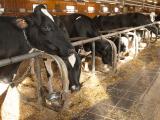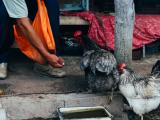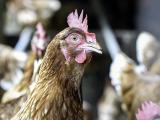Mar 19, 2008 (CIDRAP News) – Veterinary officials in Turkey have confirmed an H5N1 avian influenza outbreak in the western part of the country near the border with Greece, according to a report yesterday from the World Organization for Animal Health (OIE).
The virus struck 22 backyard chickens at a village near Ipsala in Edirne province, according to the OIE report. The remaining 16 birds were destroyed. Turkish officials listed fomites, which could involve contamination spread by humans, vehicles, or animal feed, as the source of the outbreak.
Turkey's last H5N1 outbreaks occurred over several weeks in January and February at six sites, all of which involved backyard poultry. The OIE report on the outbreaks said the source of the virus was contact with wild species.
All of the previous outbreaks occurred near villages along the Black Sea, an area that officials from the United Nations Food and Agriculture Organization (FAO) have said is vulnerable to H5N1 outbreaks, because surrounding countries are a winter home to migratory birds from Siberia and often have poor separation between wild and domestic birds. However, the OIE report map detailing the most recent outbreak location shows that the Ipsala area is close to the Mediterranean Sea.
Elsewhere, government officials in Laos reported a fresh H5N1 outbreak in chickens in Luang Namtha, in the northwestern part of the country near the border with China and Myanmar, Vietnam News Agency (VNA) reported today.
Yong Chanthalangsy, the country's foreign ministry spokesman, told VNA that 800 birds were destroyed in a 2-mile radius around the affected village and that the outbreak is the sixth to strike the area in the past month.
In mid February, Laos reported that the H5N1 virus had reemerged in poultry after about a year's hiatus, according to previous reports.
In other developments, authorities in India today began culling thousands of chickens in West Bengal's Malda district after about 1,000 birds died over the past few days at a state-run poultry farm, Reuters reported today.
Officials are testing samples from the birds to see if they died from H5N1 infection, according to the Reuters report. In early March animal health officials confirmed that the virus was responsible for killing poultry in neighboring Murshidabad district.
Since mid January West Bengal authorities have been working to stamp out the outbreaks that began in the village of Margram. The virus spread quickly, striking poultry in 13 of the state's 19 districts and prompting the culling of almost 4 million birds. In late February, the outbreaks in West Bengal appeared to be over and FAO praised the country for its control efforts. However, the group warned that the H5N1 virus could return if the county didn't maintain its control and surveillance efforts.
See also:
OIE reports on 2008 Turkish outbreak



















